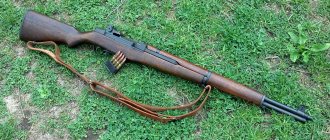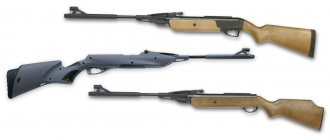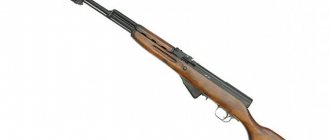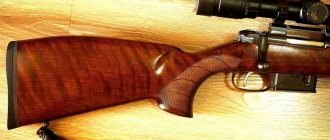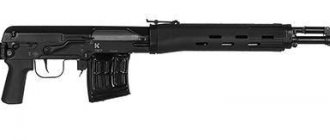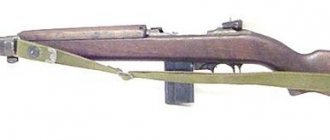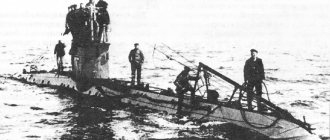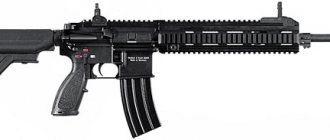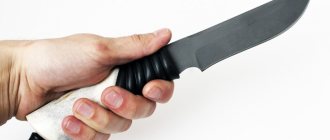Currently, the semi-automatic hunting rifle MTs-21 is not in demand among young hunters, many of whom view hunting as just another corporate entertainment. Meanwhile, this gun is still produced at the Tula Arms Plant, despite the fact that many decades have passed since the appearance of this model. During the Soviet era, having a semi-automatic weapon of this type was a real dream for any hunter.
The most popular was the MTs-21-12 shotgun, which accepts 12-gauge cartridges. The characteristics of this weapon make it a real universal shotgun with which you can kill any animal.
History of creation
The MTs-20 carbine began to be produced in the early 60s of the last century. This model was distinguished by its high reliability and power, but it cost quite a lot of money, so it is not surprising that its first modification, called MTs-20-01, was released in 1979. It differed from the original in a much simpler design, which had a low cost, but at the same time the weapon remained universal. In the first months after its release, the modification surpassed its progenitor in the number of copies sold.
Despite the fact that production of the MTs-20-01 continued until 2006, not every rifle has a low cost. This is due to the fact that in the period from 1990 to 2000, the Tula Arms Plant produced a new version of the rifle, which had a more expensive appearance and an improved design. The same legendary “frolovka” is now almost impossible to find in gun stores. It is sold mainly in second-hand stores or on various weapons forums and websites.
The history of the appearance of MTs-21
The MTs-21 hunting rifle was a real breakthrough in the Soviet hunting industry. In the second half of the 1950s, for most Soviet hunters, the ultimate dream was a double-barreled shotgun. It is interesting that instead of mastering the production of pump-action shotguns, the Tula Arms Plant began producing semi-automatic weapons.
The MTs-21 shotgun was released in 1956. The “father” of this model was the Soviet designer V. A. Nikolaev. His goal was to create a reliable weapon for hunting that would compare favorably with traditional double-barreled shotguns. Using developments and some design solutions used, Nikolaev followed the path of Kalashnikov, creating his own unique model based on world-famous developments.
Initially, the weapon was produced by TsKIB SOO, since the design of the gun was quite unusual for the Tula Arms Plant. TsKIB produced MTs-21 from 1956 to 1964. It should be noted that all the weapons produced by the design and research bureau were of high build quality, so they are very much valued among hunters. From 1964 to the present, this gun has been produced at the Tula Arms Plant.
Initially, the shotgun was produced in the following modifications:
- MTs-21-12 – 12 gauge;
- MTs-21-16 – 16 gauge;
- MTs-21-20 – 20 caliber.
The Tula Arms Plant quickly simplified production, leaving only 12-gauge weapons on the production line in 1965.
Design and principle of operation
The MTs-20-01 rifle is a hunting smoothbore carbine with a longitudinally sliding bolt and a removable box magazine. Despite the fact that this description sounds quite simple, the model has several design features that distinguish it from other shotguns and rifles:
- chrome-plated channel and chamber - taboo for rifled weapons;
- connecting the barrel to the receiver using a pin - simplifies disassembly;
- half-pistol stock and butt with a comb - relevant for smooth-bore guns;
- the presence of a rifle rear sight and an open front sight - found mainly on rifles;
- unregulated trigger mechanism - the safety sear blocks the trigger;
- spring-loaded firing pin - a distinctive feature of the Mosin rifle;
- the firing pin is cocked at the moment the bolt handle is lowered - a clear feature of a rifled weapon.
Thus, the MTs-20-01 gun is a cross between smooth-bore and rifled weapons with some innovations. However, to understand its operating principle, it is not enough just to familiarize yourself with the basic design features. You also need to study the algorithm by which the model works:
- Trigger cocking. Produced using a bolt shutter. The owner raises the handle and then moves it away from the stem in a backward motion. At this moment, the protrusion of the striker catches on the sear. The fact that the weapon is in the firing position is indicated by the safety flag, as well as the fact that the bolt is securely closed by the locking mechanism.
- Cartridge supply. At the moment when the hammer is cocked, a cartridge case from the magazine is also fed into the chamber, where they are laid in one row and are under spring pressure. The chamber window opens, ammunition is caught and fed into the barrel. After this, the cartridge case is directly next to the firing pin, which is already in the loaded position.
- Shooting and reloading. The firing mechanism is nothing special. First, the hunter removes the weapon from the safety catch, and then pulls the trigger. The firing pin hits the cartridge primer. The gunpowder ignites and propels the bullet. After this, you can open the bolt to allow the spent cartridge to fly out of the chamber.
The weapon's safety, which is located in an unusual position for a smoothbore gun - on the neck of the stock - deserves special mention. It looks like a regular flag covering a red or green button. If a red indicator is visible, it means the weapon is ready for battle. If green, the carabiner is in safe mode.
MAKSIMOV.SU
This light, reliable, inexpensive and productive gun has never been called anything in our country.
The legendary fishery, developed in the early 60s, under the leadership of Yu.I. Berezin, was affectionately called by hunters simply “twenty”, and “berdanka” and, “in the urban way,” “emtseshka”.
With this gun, which immediately became popular and scarce, Russian hunters hunted almost all the living creatures living on the territory of the USSR - from squirrels to moose. The specificity of the design, the attractiveness of the palette of small calibers, the lightness and versatility of the MTs20 (MTs20-01) - these factors have become decisive when choosing a weapon for several generations of hunters.
Shotgun MTs 20-01
Produced at TOZ, the commercial smoothbore hunting rifle MTs20 (20-01) was a single-barreled three-shot shotgun, produced in 20, 28 and 32 calibers and having a rifle layout and design. The gun was produced with a wooden or plastic stock, mainly in 20 gauge.
Feeding is carried out from a 2-place detachable box magazine. The bolt is longitudinally sliding; in the first version it had a number of serious design flaws. The barrel, connected to the receiver by a pin and a guide sleeve, had a front sight on a long base and a rear sight. Barrel length – 600 mm, muzzle narrowing, barrel bore and chamber are chrome-plated. Chamber length – 70 mm.
Shotgun MTs 20-01
The safety slide is located on the shank of the receiver. The non-adjustable trigger mechanism is mounted on a separate base. The weight of the gun is 2.6 – 2.75 kg, depending on the caliber.
In addition to defects in the bolt group, the biggest drawback of the MTs-20 was the plastic stock, made integral with the receiver, also plastic. For its time, such a design solution was revolutionary, but unsuitable for the use of “plastic” MC in all regions of the USSR, which have a huge difference in average annual temperatures. Because the bolt was dangling in the plastic receiver, its movement was very difficult. The plastic box often cracked, and then the gun could not be repaired. The fuse also caused complaints.
Shotgun MTs 20-01
The MTs20-01 shotgun, which we see on the shelves of hunting stores today, was created in the late 70s. Representing a modernized MTs20-20, the production of which ceased in 1971, MTs20-01 has been produced since 1979 and is in considerable demand these days.
Unlike the MTs-20, the modernized MTs20-01 shotgun has a steel receiver rigidly connected to the barrel, two symmetrical bolt lugs, a bolt liner and a cocking indicator.
The design of the reflector and shutter stop has been changed. The shutter began to be disassembled without the use of tools. Shotgun MTs 20-01, safety
The barrel is chrome plated. The stock is only wooden, with a pistol neck, made of birch or beech, reinforced with a dowel screw. The gun has two screw-mounted swivels, hunting type. It is equipped with two 2-seater magazines, very original in design and method of fixation.
Currently, in addition to the basic model MTs20-01, since the beginning of the 90s, TOZ has been producing 3 modifications: MTs20-08, MTs20-09 and TOZ-106 (MTs20-04), differing in the presence or absence of a stock, its design and length trunk The weight of the MTs20-01 shotgun from our article is 2.8 kg, the total length is 1150 m, the barrel length is 600 mm. Sighting line length 610 mm. Trigger force: less than 2 kg.
The gun has a good shot action, shoots well with a bullet, is very light, easy to use and well weighted. But in order for an inexpensive gun to please its owner, you need to be careful when purchasing and find a little time to refine it.
Shotgun MTs 20-01,
upper part of the receiver
Choice MC 20-01
When choosing a shotgun MTs20-01, the most significant criteria can be taken as follows (in descending order of importance): quality of the barrel, fit of the bolt, operation of the trigger and safety, metal sediment in the stock. Various minor annoyances, such as a very heavy shutter travel and a poorly fixed magazine, can be safely ignored. Because, sad as it is, working with sandpaper and a file cannot be avoided if you really want to enjoy shooting and be confident in your weapon.
When inspecting the barrel, you must pay attention to the lack of variation in the thickness of the muzzle and the ovality of the choke constriction. The barrel of the MTs20-01 rarely has other defects. Which, of course, does not eliminate the need for a standard barrel inspection procedure. The front sight is sometimes soldered crookedly, so you shouldn’t forget about it either.
When inspecting the shutter, it is necessary to check the functioning of the locking unit and trigger. With confident loading of the cartridge case into the chamber, precise (albeit heavy) operation of the bolt, normal operation of the trigger and vigorous extraction of the cartridge case, you can think about purchasing this particular specimen.
Shotgun MTs 20-01,
trigger guard, magazine receiver, magazine cover
Finishing MTs 20-01
Work on fine-tuning the mechanics and ergonomics of the gun is carried out in two main areas:
- Grinding of ALL mating surfaces of the bolt and receiver.
- Improving the ergonomic characteristics of gun controls and reloading.
If the second point comes down to refining the neck of the stock of ordinary shotguns, optimizing the pitch and thickness of the ridge of the stock, installing a rubber shock absorber and refining the bolt handle, then the first point should be discussed in more detail.
The extremely tight operation of the MTs20-01 bolt, especially when lifting its handle up, is the result of poor processing of the gun parts, nothing more. If desired, you can be guaranteed to achieve such light and smooth operation of the shutter that when firing the shutter you can control it with two fingers, and even the sound of the shutter itself will become “oily,” clear and pleasant, radically different from the previous very unpleasant grinding noise.
When the bolt handle is raised up, with the trigger pulled, stiffness is created by:
a) incorrectly profiled geometry of the worm cocking hammer and its rough processing;
b) too deep a recess for the trigger teeth and their discrepancy in size and geometry;
c) unpolished surfaces of the bolt lugs and the corresponding contact planes of the cutouts in the receiver;
d) unfinished planes of the rear end of the bolt stem and the front end of the liner;
e) rough processing of the outer surface of the bolt and the receiver channel;
f) incorrect fit of the valve insert (relative to its longitudinal axis), as a result of which the load on the contact planes of the insert is distributed unevenly.
Gun MTs 20-01,
branding on the receiver
As a rule, working with sandpaper and a file is necessary in all respects (but extremely carefully). The worm-gear cocking geometry and lug lugs require special attention. If there is a sharp increase in force when lifting the bolt handle, until the first click, you should pay attention to the correct “sharpening” of the front part of the trigger, the shape of the recess of the trigger lock and, holding the removed bolt in your hands, by rotating the liner, identify areas that prevent the trigger from sliding in the worm cutout of the stem .
Then use a needle file to remove excess metal and grind it with a “null” wrapped around a round needle file. It is difficult to give an exact recipe for “treating” this most common and significant problem MTs20-01, so owners of a gun with a “heavy” bolt will have to “listen” to their weapon themselves, because the standard problem is individual for each specimen. The reason for this is the rather large share of manual labor used in the production of MTs20-01.
Shotgun MTs 20-01,
case extraction
On some copies of the MTs20-01, the position of the insert on the assembled bolt may not correspond to the grooves in the receiver. As a result, the front surfaces of the planes of the liner, when closing the bolt, stick into the end of the receiver and, to align the guide protrusions of the liner, additional force is required.
To reduce this consequence of careless assembly, on the liner of carelessly assembled samples, “lead-in” chamfers have to be made on both sides, allowing the shutter to be closed normally. In addition, you can grind the bolt lugs to the receiver lugs. Be sure to chamfer the shutter stops and generally wherever possible, but without fanaticism. After this, sanding again.
Such a comprehensive “licking” of the mechanics of a gun is not a manic syndrome, but a necessity if you want to have a reliable weapon. If possible, it is advisable to modify the bolt handle by welding a normal-length stem with a classic “ball”.
Shotgun MTs 20-01
After processing the bolt, it is necessary to grind the channel in the receiver. Particular attention should be paid to the planes of the box channel along which the shutter slides. Before starting work, carefully work the shutter again, listening to the metal and identifying the places of greatest friction.
USM grinding is usually not necessary. The descent of the MTs20-01 “out of the box” is already quite satisfactory. And it requires intervention only in open marriage. By the way, with the trigger block removed, polishing the receiver channel is much easier. It is also advisable to grind the slide stop slides, which, being poorly processed, create additional resistance during axial movement of the shutter.
Standard magazines of the MTs20-01 and its derivatives often fall out when fired. The magazine falls out due to poor fit of their locking protrusions to the contact surfaces of the frame. Fixing this problem requires a maximum of 10 minutes of file work. You need to use a triangular file to grind off a little bit of metal on the side protrusions of the magazine. The magazine, even when equipped, should easily snap into its socket. Play in a fastened empty magazine is not a defect.
Shotgun MTs 20-01,
shotgun butt
It is advisable to sand the magazine bends and the top surface of the feeder, which will eliminate another rough surface and significantly improve the magazine fit and cartridge feeding. Four-round magazines, produced by some unknown company, are less reliable than standard 2-round magazines. Unrolled and brass sleeves are fed much better than rolled ones. The reason for this is the calculation of the length of the magazine and the cartridge supply path for the brass sleeve, for which, first of all, the basic model MTs20-01 was developed.
Refinishing the stock involves removing the old coating and applying a tinting compound. The best means for protecting wood, in our conditions, is traditionally beeswax.
This is where the main standard operations for fine-tuning the MTs20-01 and its clones end, although perhaps some little details were missed in consideration. All further research depends on the imagination and needs of the owner. For those who are pessimistic about the quality of the MTs20-01, I will inform you that now you can often find impeccably assembled copies of the “emtseshka”.
Shotgun MTs 20-01,
front part of the stock forend
Conclusion
At the moment, when our arms market is oversaturated, we have an extremely limited range of models as a classic smoothbore hunting shotgun. And the MC20-01, which has an adequate price-quality ratio, most fully meets the field requirements.
Of course, sometimes a double-barreled shotgun is preferable for fishing, but they rarely come in small calibers. Today the MTs20-01 is often purchased for recreational shooting, because it is sometimes more suitable for this than self-loading, because less demanding on ammunition and notable for its reloading principle.
Shotgun MTs 20-01
For many shooters who do not yet have a rifle, the MTs20-01 is a good alternative, allowing them to practice handling skills with a classic bolt-action rifle. Nowadays, this is what is most attractive about MTs20-01. And the minimum price, whatever one may say, more than compensates for the shortcomings in manufacturing and assembly quality.
The MTs 20-01 shotgun
has always been considered a fishing weapon
The article was published in the magazine "Hunting"
Specifications
Despite the fact that the main advantage of the MTs-20-01 is its unique design, the weapon also has good technical characteristics. You can find them in the weapons passport in the form of a small table:
| Characteristic: | Parameter: |
| Weapon caliber: | 28 or 32 |
| Chamber length | 70 mm |
| Barrel length | 635 mm |
| total length | 1150 mm |
| Gate | bolted, longitudinally sliding |
| Damage range | up to 60 meters |
| Magazine capacity | 2 + 1 rounds |
| Gun weight | 2.8 kg |
MTs-20-01 shotgun in disassembled form
As for the accuracy of the fire, it is within 45% when firing shot from a distance of 35 meters - not the best indicator for a smooth-bore weapon, but quite adequate for a near-caliber carbine. In addition, the MTs-20-01 gun is used mainly for shooting marsh and meadow birds (hazel grouse, snipe, quail, and so on), and such game usually only needs one pellet to drop dead.
Modifications MC 20
In addition to the MC-20-01, the gun is also available in other modifications, each of which was created in order to satisfy the individual needs of hunters. Here is a brief description of only those models that are considered the most popular:
- MTs-20-02 is a modification developed on the basis of the basic model, but is produced only in 28 caliber. All major defects of MTs-20-01 have been changed. The gun also has a thread for installing an additional choke or sound moderator.
- MTs-20-04 - better known as TOZ-106 or “Death of the Chairman”. The gun has a shortened barrel, as well as a telescopic butt made of metal. Weapons are used mainly for security purposes and amateur hunting.
Carbines MTs-20-04 (TOZ-106)
- MTs-20-07 is a sports version of a standard rifle with a long butt, designed for competitive and training skeet shooting. The model uses 32 caliber cartridges for ammunition, loaded with shot or bullet.
- MTs-20-08 is a civilian modification created in order to satisfy the needs of customers for self-defense. The weapon is equipped with a short barrel and a pistol grip. The firing range does not exceed 40 meters.
- MTs-20-01Sh is a one-piece version of everyone’s favorite gun, distinguished by a unique appearance. For example, on the receiver and butt there are carvings and frescoes in the form of animals and birds, and some versions were even produced with gilding.
Piece shotgun MTs-20-01SH
Despite the fact that the choice among modified weapons is quite extensive, the MTs-20-01 shotgun remains the most popular simply because it is universal. Amateurs especially often buy weapons because they are highly reliable and low in cost.
Modifications and features of MTs-21
Currently, the Tula Arms Plant produces its automatic shotgun only to order. The gun comes only in 12 gauge and comes in the following modifications:
- The gun is in an ordinary version;
- The gun is a piece;
- A souvenir gun.
In addition, it is possible to order a modification MTs-21-12R, which differs from the standard model by the presence of a rubber butt pad. The main feature of the shotgun is the presence of a safety lever. In addition, the weapon can fire cartridges in both paper and plastic casings.
In order to remove all cartridges from the gun, the following operations are required:
- The gun is put on safety;
- The cartridge that is in the chamber is removed. To do this, you need to turn off the cartridge feed mechanism. Then the shutter is retracted to the rearmost position. To change the cartridge in the chamber, you need to do the same;
- The cartridge feeder needs to be recessed, and at the same time it is necessary to press the cartridge stop in the shotgun bolt.
In order to quickly replace one type of cartridge with another during the hunting process, you simply need not fill the magazine to capacity. This makes it possible to insert the cartridge that is needed at that particular moment at the right time.
Advantages and disadvantages
During the creation of the MTs-20-01, the engineers of the Tula plant tried to endow the new weapon not only with a unique design, but also with other positive qualities that would affect the demand among hunters. As a result, the carbine acquired the following advantages compared to its competitors:
- Rigid fixation of the barrel in the receiver. Guarantees that the weapon will last for many years, and also that it will have a good accuracy rate, despite the small caliber. This is especially true for bullet shooting.
- Simple and inexpensive design. If it happens that some part breaks, replacing it will not be difficult even for a novice hunter. Well, spare parts cost mere pennies compared to parts for foreign shotguns and rifles.
- Reloading a shotgun requires little physical effort, unlike breakshots and even pump-action shotguns. The bolt cocking always works properly and does not require modifications by the owner.
The weapon's shortcomings are usually due to the fact that the carbine's build quality is quite floaty. Buyers every now and then come across a product that has some kind of defect: either the magazine is poorly attached to the barrel, or burrs stick out on the chamber. Unfortunately, it is not always possible to fix all the problems yourself, so we advise you to pay attention to some features when purchasing a rifle.
How the weapon works
MC-21 works according to the following principle:
- When a shot occurs, the barrel is engaged with the bolt;
- The pressure of the powder gases affects the bolt, and it begins to move along with the barrel;
- When the bolt moves, the hammer is cocked, the mainspring, the recoil spring and the barrel spring are compressed;
- The return of the barrel and bolt to the forward position occurs due to the action of springs. Initially, only the barrel returns back, and the bolt is held in the rear position by the feed lever. When the bolt is disengaged from the bolt, the barrel is unlocked. Returning the barrel ejects the cartridge case and activates the cartridge feed mechanism;
- Then the bolt comes back, which sends the cartridge into the chamber, recesses the feeder tray and locks the barrel channel.
After this, the whole cycle repeats. When the last round is used, the barrel will return to the forward position and the bolt will remain in the rear position.
What to look for when choosing
Not all MTs-20-01 samples are of the same quality. Some versions are delivered to the market in almost perfect condition (especially new ones), others have minor flaws, and others are clearly defective. To avoid disappointment with your purchase, you should pay attention to the following points:
- Barrel quality. Under no circumstances should the barrel channel be crooked or have visible deformations. You should also carefully inspect the muzzle and chamber for the presence of burrs, which are often found on this model of carbine. They can be eliminated, but it is still better to choose a model that does not have manufacturing defects.
- Shutter quality. Noticing any defects in the bolt frame can be problematic for a person who does not understand the structure of the weapon. Usually the operation of this mechanism is checked by recharging. If the lever moves smoothly and evenly, then the weapon has no defects. If resistance is felt, then the weapon will have to be modified.
- The junction of the stock and the metal. Sometimes when purchasing, you may come across models that are characterized by poor quality of the connection of wooden and metal parts. If you do not notice these shortcomings when inspecting the weapon, then it will be very difficult to eliminate them in the future - you will have to completely replace the stock or file down the metal.
- Reliability of fuse operation. And we are talking not only about the system that serves as protection against an accidental shot, but also about the bolt lock, which sometimes has problems. They can only be detected by checking how tightly the frame is closed when the hammer is cocked. You can verify the quality of the fuse by pressing the trigger firmly.
- USM. If a rifle is purchased secondhand, the buyer has the right to ask the owner to completely disassemble the rifle or shotgun in order to inspect how well the trigger mechanism is made. Particular attention should be paid to springs, which often stretch during operation.
These are just the main points to look at when choosing a gun. Also, do not forget to check the appearance of the weapon. The butt and stock should under no circumstances have cracks, otherwise over time they can lead to the splitting of the wooden part. If possible, it is also worth taking a few test shots to check how the rifle behaves in combat conditions.
Design of the Tula semi-automatic machine
The first Tula semi-automatic machine had the following design:
- Automatic reloading took place through the use of the energy of powder gases. It is based on the principle of recoil with a long barrel stroke;
- The MTs-21-12 barrel is removable and movable. It has a ventilated sighting rib. The barrel channel is chrome-plated;
- The trigger mechanism of the gun is designed only for firing single shots.
Before firing the first shot, it is necessary to move the bolt of the MTs-21-12 all the way back. This will automatically cock the trigger. The shutter will be locked using a special lever.
Hunters note that the automatic shotgun often does not work correctly. It happens that cartridges are not ejected after firing a shot. This problem usually went away on its own after firing about 500 rounds. The problem was that due to the shortage of ammunition, not every Soviet hunter could afford such target shooting.
The MTs-21 used a flag-type fuse, which was very rare for a hunting weapon. This fuse reliably blocks the trigger.
Since this gun was intended mainly for professionals, its stock and forend were made only of beech or walnut. The forend is removable, it is secured by a nut, which is made in the shape of a cap. When disassembling the weapon, the forend can be easily removed.
The tubular magazine holds 4 rounds. Such under-barrel magazines had not been used on hunting weapons before, but the designers managed to cope with the task perfectly. The cartridges are fed into the chamber automatically. When the bolt moves forward after firing, it feeds a cartridge. It is possible to disable the automatic supply of ammunition.
As for the external decoration, even ordinary guns of this model had a flat ornament on the metal parts. Piece and souvenir modifications were decorated with artistic engraving. Even the chasing of external metal parts was common.
Refinement and tuning
Don't be upset if you purchased a weapon and it turned out to have some kind of defect. As a rule, most factory errors can be eliminated at home. To do this you may need the following tools:
- file - for removing coarse burrs and irregularities;
- medium-grain sandpaper - for sanding the surface;
- jigsaw - will eliminate errors on wooden parts.
Modified MTs-20-01 shotgun with a reinforced stock.
Well, when the weapon is perfected, it can be modified by installing a modern “body kit” or carrying out some manipulations with the design. Here is a list of the main tuning works for MTs-20-01, which are popular among owners:
- Installation of an optical sight. Without it, MTs-20-01 is like a man without hands. Such a “body kit” not only increases shooting accuracy at medium and long distances, but also allows hunting at a distance of several hundred meters from the target.
- Mounting the underbarrel flashlight. Fans of wild boar or elk hunting often install a small flashlight under the rifle barrel to illuminate the area. However, to do this, you will first have to attach a Weaver or Picatinny sight rail to the forend.
- Installing an additional choke. Further increases the accuracy of combat at long distances. With a choke on the barrel, the optic can become useful not only when shooting bullets, but also shot or buckshot.
- Replacing the standard stock and stock with plastic analogues. Plastic weighs almost the same as wood, but is much less subject to mechanical stress. However, when choosing parts, you should pay attention to their size so that there are no problems with fit.
- Collimator sight mount. If you have the money for a battery-powered device, why not attach it? The collimator is suitable for hunting at distances of up to 100 meters and simplifies the aiming speed several times.
- Applying fiber optics to the front and rear sights. You can also attach a special thread to the standard sighting device, which simplifies the process of aiming in the twilight. It is usually made in green or red.
Despite the fact that the MTs-20-10 rifle is quite cheap, it represents a good base for modernization. If desired, the weapon can be changed beyond recognition, especially if the owner’s supply of money and time is unlimited.
Hunting features and owner reviews
The main feature of hunting with the MTs-20-01 shotgun is that it is designed for small-caliber cartridges. The destructive power of such ammunition is enough to kill a duck, hare, pheasant, fox and other small fur-bearing animals and birds. But when shooting at a goose, there is a chance that the bird will not die in one hit. So the MTs-20-01 is not suitable for hunting every animal.
The rifle is in great demand among professional hunters and commercial hunters who need additional, highly targeted weapons. The model looks good with optics and a collimator, so there shouldn’t be any problems with hitting it. If 28- or 32-caliber ammunition is selected correctly, then there will be no large wounded animals left for game.
Some hunters replaced the barrel of their weapon with a 20-gauge one and shared their impressions with colleagues. In a nutshell, this procedure did not lead to anything good. The power of the trigger is not enough to ensure that the 20-gauge cartridge has optimal accuracy. So it is recommended to use only those ammunition for which the carbine is designed.
Recommendations for weapon maintenance
Maintaining a gun involves following a number of rules and recommendations:
- before using the gun, it is necessary to remove grease from the barrel, chamber and other parts;
- It is better to store the weapon with the trigger pulled, this will avoid spring subsidence;
- Before using the weapon, you should check all connections, including tightening screws;
- Do not allow dirt, water or other foreign substances to enter the barrel;
- Do not point weapons at people or pets;
- inspection and cleaning of the carbine should be carried out at least once a month and immediately after shooting;
- If there is no cartridge in the magazine, you should not shoot empty, this will lead to wear on the mechanism.
Prices and analogues
A few words about how much the MTs-20-01 rifle will cost. As mentioned earlier, it is unlikely that you will be able to find this rifle in gun stores, and former owners can set a different price tag on their weapon, depending on its condition. However, usually the cost of a carbine does not exceed 12 thousand rubles.
As for analogues, it is quite difficult to find a worthy competitor for the MTs-20-01 on the arms market due to the unique design. Although there is still one model - the Muflon-410 carbine from . This gun is also a Mosin rifle design, but the smooth barrel only fires small-bore rounds (410 caliber).
MTs-20-01 is a very controversial, but very interesting carbine that definitely justifies its cost in capable hands. Thanks to its simple design and high reliability, the model is popular not only among professionals, but also among amateurs. Although for a hunter who wants to go hunting for a large animal, it is worth looking for something more powerful.
Possible problems and benefits
MTs-20-01 has some disadvantages, which are mainly related to the quality of workmanship. The design of the latches is not entirely successful, so the magazine often spontaneously falls out of the weapon. Many hunters note the poor design of the sight, which makes it difficult to aim at the target when shooting. To improve the quality of the carbine, hunters independently strengthen the design of the stock and add their own elements for more successful shooting.
Among the advantages of the gun are the following:
- it is undemanding to operating conditions and is easy to assemble;
- with proper care it will last a long time;
- for MTs 20-01 you can use reinforced cartridges;
- weapons are available in various modifications, you can also order individual copies;
- MC 20-01 and its components have an affordable price.

